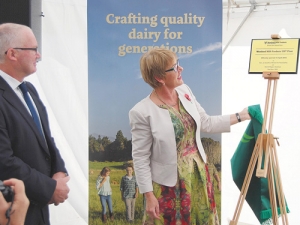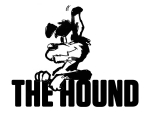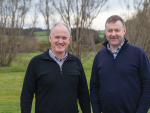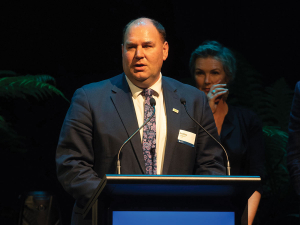Adding value to New Zealand's dairy produce was the strong theme of the official opening of Westland Milk Products' new UHT plant at Rolleston last week.
Westland has hit the ground running with the $40 million plant, with commercial production underway and "substantial orders" already received. The company has hired its first overseas permanent staff, at an office in Shanghai, and plans to launch its UHT (ultra heat treated) long-life milk and cream in the Chinese market in June.
The plant, under construction since March 2015, was officially opened on April 15. A 3.6mMW LPG-fuelled boiler can process up to 14,000L/hour of white milk or 9000L/h of formulated whipping cream. Tetra Pak packaging lines fill containers ranging from 250ml consumer packs with built-in straws to 1000L commercial boxes.
The plant is Westland's first foray into producing and exporting liquid milk and cream, adding to its well-established milk powders. Chief executive Rod Quin calls it "a significant milestone in the company's strategy to move away from the volatile, and currently oversupplied, bulk dairy ingredient market".
"Our focus is now on producing high-profit, added-value products for the top end of the market."
Holding up a 250ml pack to guests at the opening, Quin said it would represent only 9-10 cents of 'commodity' milk to the farmer, but as UHT milk processed for the Chinese market would sell for $1.30 – a big gain even after marketing and distribution costs. Similarly, the company's 1L UHT whipping cream would sell in China for about $6.80.
"So that's our initial foray into UHT but it will not stop there," Quin said. "Part of the plant design is around a mixing unit mixing dairy and non-dairy components to then develop things like sports drinks, flavoured drinks and potentially aged nutrition. That's where the true added-value starts to flow."
Opening the plant, the Minister for Food Safety, Jo Goodhew, acknowledged a difficult time for dairy, in "a world awash with milk". But she assured guests the Government was working towards a goal of doubling NZ's export value by 2025.
"Free trade agreements are fantastic and we know dairy will benefit from the TPP, perhaps not as much as they wanted but there will be a significant benefit. Then you've got the non-tariff barriers and... the Government is focused on that too.
"Market expectations are for a product that is much more than a commodity. You are delivering.... Congratulations on [helping] us achieve our goal of doubling value by 2025."
Westland's chairman, Matt O'Regan, told guests the plant arose from a 2010 decision to improve shareholders' return through processing more milk – 18% now comes from Canterbury suppliers – and pursuing value-added projects, including a purpose-built nutrition plant at the Hokitika headquarters already producing 30,000 tonnes/year of infant formula, and the new Rolleston UHT venture.
"UHT processing is not new but quality milk and cream produced from NZ receives a premium in the Chinese market, and will lead us to work with our customers to develop UHT products for an ever-discerning consumer," said O'Regan.
Quoting Charles Darwin as saying it is neither the strongest nor the most intelligent of a species who survive, but the most responsive to change, O'Regan said the new plant was as significant as was Westland's first dryer producing milk powder in Hokitika 50 years ago.
"World commodity prices have fallen through the floor. Current returns to dairy farmers are unsustainable for our dairy industry to survive.
"In Europe last month we talked to many involved in the European dairy industry; I believe it will be 18-24 months before we see dairy prices increase to the $5-$6/kgMS required to sustain our industry."
Although Westland's Westgold brand is already established internationally, Quin said the new Chinese market labeling translates as 'Nourishment from the Pasture'.











